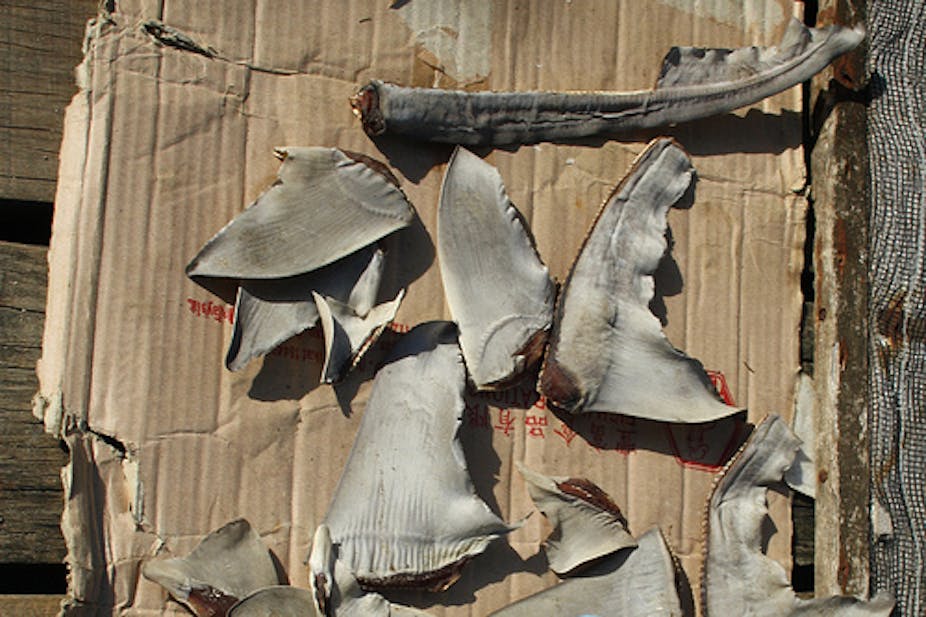Whether it’s from fishing and by-catch, finning or even culling, global shark populations are under a growing threat from human activity. But how successful is international law at protecting some of the planet’s oldest species?
Only two of the global legal instruments that protect sharks are legally binding: the Convention on Migratory Species (CMS) and the Convention on International Trade in Endangered Species (CITES).
While there are other non-binding agreements aimed at addressing shark conservation and management, the overall legal framework is not comprehensive. The result is that international law offers at best only a limited level of protection for sharks.
The Convention on Migratory Species (CMS)
When species are listed under the CMS they are protected throughout their migratory range. Three shark species are listed on Appendix I: the Whale Shark, Basking Shark and Great White Shark. This means any states in their “range” must prohibit catching the species.
Range states include those countries in whose waters the species are found, and nations who register vessels that fish on the high seas.
Four further species are listed on Appendix II: the Porbeagle, Spiny Dogfish, Short Fin and Long Fin Mako. For these species, range states have to enter into agreements with each other to protect them.
CMS signatories signed up to a Memorandum of Understanding on sharks in 2010. In September 2012 they agreed involvement in CMS should go beyond States and that NGOs, scientists and fishing industry representatives also needed to be involved. Relevantly, the US and Australian chapters of the Humane Society International signed on to the Memorandum.
Importantly, the parties adopted a Conservation Plan for sharks. This recognises the importance of research, sustainability of fisheries, protection of critical habitats, public education and international cooperation.
The meeting also recommended that sharks be landed with their fins naturally attached. This measure is aimed at reducing the abhorrent practice of live finning - the fins are cut off the shark while it is alive, and the shark is left to bleed to death or drown. In some cases the sharks are dead when the fins are removed but the bodies are still wastefully discarded.

This finning should be distinguished from circumstances where sharks are landed whole and their meat and fins separately sold. It is the former practice that is most controversial, unsustainable and breaches guidelines on responsible fishery practice.
The shark fin industry is driven by the high prices fishers can get for fins. Meat is not as profitable. This recommendation is therefore a significant advance. It follows a 2008 UN General Assembly Resolution and comes in the wake of shark fin regulations in countries such as the US, and a number of Pacific nations. Although not legally binding on countries, the recommendation illustrates growing consensus on the need to address shark finning and endorses the “fins naturally attached” approach. The recommendation will hopefully catalyse the development of binding regulations in regional fishery management organisations and at the national level as well.
Although the global community acknowledges the poor conservation status of some shark species, ultimately, the CMS Memorandum is not legally binding and only covers the seven species listed under the Convention. Furthermore, only 50 states have signed the document and by extension committed to the Conservation Plan.
The Convention on International Trade in Endangered Species (CITES)
The other legally binding international instrument is CITES. This regulates international trade in species listed under the treaty. International trade in species listed on Appendix I is prohibited. Three shark species are listed on CITES Appendix II - the Whale Shark, Basking Shark and Great White Shark. These species can be internationally traded, but trading must be tracked with import and export permits. These permits are only granted where the trade will not negatively impact on the conservation status of the species.

In preparation for the next CITES meeting in 2013, seven further species of sharks and manta rays have been submitted for listing: Porbeagle, Oceanic Whitetip, Scalloped, Smooth and Great Hammerhead sharks, as well as the Oceanic and Reef manta rays.
The outcome of the CITES applications will not be determined until March 2013. But even if these listings are successful, the fact remains that the vast majority of the more than 1000 species of shark (including at least 95 migratory species), will remain unprotected and unregulated at the global level.
Ultimately, it is left to States to implement international obligations at the domestic level and therefore these treaties do not directly prevent countries from adopting unsustainable policies which may have a negative effect on sharks.
What next in shark conservation?
The international community has tried to provide a more comprehensive regime through the FAO International Plan of Action for Sharks. But this is not legally binding and its implementation at the national level has been limited and inconsistent. The only other relevant mechanisms are conservation measures under the Regional Seas Conventions and Regional Fishery Management Organisations, but again these lack consistency.
The distribution and variety of mechanisms across a number of legally binding and non-binding instruments has resulted in complexity and fragmentation. There are no comprehensive protections afforded to sharks broadly. This is a significant barrier to addressing the growing shark fin industry and emerging problems, such as the market in shark liver oil.
It will take a much more concerted and harmonised global effort if the future of some of the planet’s oldest species is to be assured.

